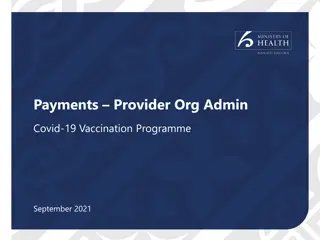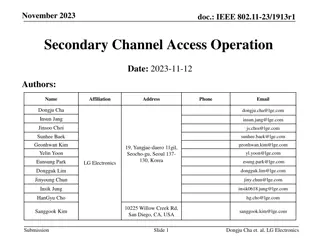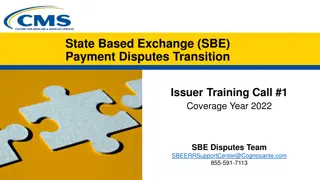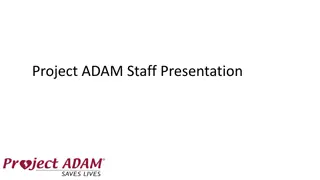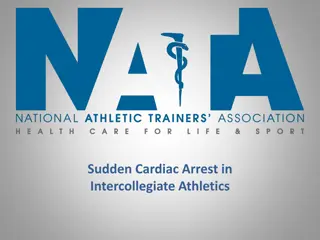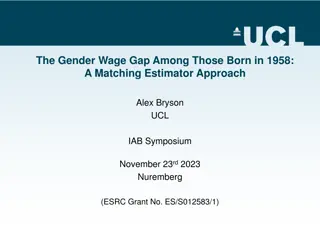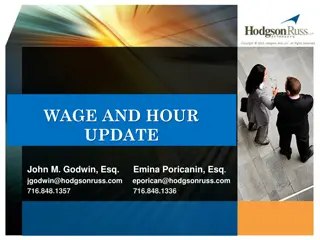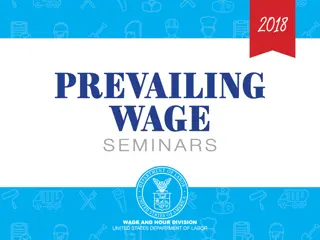Wage Determination and Payment Compliance under SCA
The Service Contract Act (SCA) mandates contractors and subcontractors to pay service employees prevailing wage rates and fringe benefits, with strict guidelines on wage determination, payment deadlines, and recordkeeping. Compliance with SCA principles is crucial to avoid penalties and ensure fair compensation for employees.
Download Presentation

Please find below an Image/Link to download the presentation.
The content on the website is provided AS IS for your information and personal use only. It may not be sold, licensed, or shared on other websites without obtaining consent from the author.If you encounter any issues during the download, it is possible that the publisher has removed the file from their server.
You are allowed to download the files provided on this website for personal or commercial use, subject to the condition that they are used lawfully. All files are the property of their respective owners.
The content on the website is provided AS IS for your information and personal use only. It may not be sold, licensed, or shared on other websites without obtaining consent from the author.
E N D
Presentation Transcript
SCA Compliance Principles Payment of wages Payment of fringe benefits Vacation Fringe Benefits Holiday Fringe Benefits Deductions Recordkeeping Notice to employees
Payment of Wages The SCA requires contractors and subcontractors performing services on prime contracts in excess of $2,500 to pay service employees in various classes no less than the wage rates and fringe benefits found prevailing in the locality, or the rates (including prospective increases) contained in a predecessor contractor's collective bargaining agreement. For contracts equal to or less than $2,500, contractors are required to pay the federal minimum wage as provided in Section 6(a)(1) of the Fair Labor Standards Act.
Payment of Wages (29 C.F.R. 4.165) Wages established by wage determination, otherwise FLSA minimum wage (29 C.F.R. 4.165(c)) Monetary wages to be paid when promptly due (29 C.F.R. 4.165(a)(1)) No distinction between Full and Part Time Employees(29 C.F.R. 4.165(a)(2)) Calculated on fixed and regularly recurring workweek of 7 consecutive 24-hour workday periods (29 C.F.R. 4.165(b)) Payroll records kept on this basis Bi-weekly or semi-monthly pay periods if advance notice
Finding the Correct Wage Rate Workers must be paid the wage rate set forth in the wage determination for the classification of work they perform. To prevent misclassification, it is very important that a contractor fully utilize the applicable wage determination and the Directory of Occupations to find the classification that most closely matches the workers duties.
Finding the Correct Wage Rate - Example Contractor X has been awarded a contract to provide refrigerated warehouse services. Contractor X is trying to determine the correct classification for the employees who receive goods to be stored, verify the goods against the incoming bills of lading, and record and route them for appropriate storage. When goods need to be shipped, the employee also verifies the goods against the incoming order and prepares the outgoing bills of lading. Contractor X begins to read through the applicable wage determination and decides that Order Clerk is the best classification. However, a further reading of the wage determination and Directory of Occupations indicates otherwise.
WD Sample Order Clerk **Fringe Benefits Required Follow the Occupational Listing** OCCUPATION CODE - TITLE FOOTNOTE RATE 01000 - Administrative Support And Clerical Occupations ********************** 01111 - General Clerk I 10.33 01112 - General Clerk II 11.52 01113 - General Clerk III 12.65 01120 - Housing Referral Assistant 17.13 01141 - Messenger Courier 10.12 01191 - Order Clerk I 11.31 01192 - Order Clerk II 12.34
Directory of Occupations Order Clerk 01190 ORDER CLERK (Occupational Base) The Order Clerk receives written or verbal purchase orders. Work typically involves some combination of the following duties: quoting prices, determining availability of ordered items and suggesting substitutes when necessary, advising expected delivery date and method of delivery, recording order and customer information on order sheets. The Order Clerk is responsible for checking order sheets for accuracy and adequacy of information; ascertaining credit rating of customer; furnishing customer with confirmation of receipt of order; order follow up, or informing customer of a delay in delivery. The Order Clerk maintains order files and verifies shipping invoices against original orders. 01191 ORDER CLERK I This position handles orders involving items that have readily identified uses and applications. The Order Clerk I may refer to a catalog, manufacturer's manual or similar document to insure that the proper item is supplied or to verify the price of order.
WD Sample Shipping/Receiving Clerk 21000 - Materials Handling And Packing Occupations **************************************** 21020 - Forklift Operator 21030 - Material Coordinator 21040 - Material Expediter 19.21 21050 - Material Handling Laborer 11.22 21071 - Order Filler 21080 - Production Line Worker (Food Processing) 13.53 21110 - Shipping Packer 12.87 21130 - Shipping/Receiving Clerk 12.87 13.53 19.21 11.98
Directory Shipping/Receiving Clerk 21130 SHIPPING/RECEIVING CLERK The Shipping/Receiving Clerk performs clerical and physical tasks in connection with shipping goods of the establishment in which employed and receiving incoming shipments. In performing day-to-day, routine tasks, this worker follows established guidelines. In handling unusual non-routine problems, this worker receives specific guidance from supervisor or other officials. This incumbent may direct and coordinate the activities of other workers engaged in handling goods to be shipped or being received. Shipping duties typically involve the following: verifying that orders are accurately filled by comparing items and quantities of goods gathered for shipment against documents; insuring that shipments are properly packaged, identified with shipping information, and loaded into transporting vehicles, and preparing and keeping records of goods shipped, e.g., manifests, bills of lading. Receiving duties typically involve the following: verifying the correctness of incoming shipments by comparing items and quantities unloaded against bills of lading, invoices, manifests, storage receipts, or other records, checking for damaged goods, insuring that goods are appropriately identified for routing to departments within the establishment, and preparing and keeping records of goods received.
Wage Payments for Work Subject to Different Rates Employee must be paid: Highest rate for all hours worked; unless Employer s payroll records or other affirmative proof show periods spent in each class of work. Applies when employee works part of workweek on SCA-covered and non-SCA- covered work.
Tipped Employees 29 CFR 4.6(q) and 4.167 Employers may use a tip credit to meet their SCA prevailing wage obligation if: The employees work in an occupation in which they customarily and regularly receive over $30 a month in tips The employer informs the employees of the tip credit before using it The employees are allowed to keep all tips individually or through a valid tip pooling arrangement The employer can show that the employees actually received the required SCA wage through a combination of direct wages and tips
Tipped Employees 29 CFR 4.6(q) and 4.167 If all the necessary requirements are met, employers may claim a tip credit to the extent permitted by section 3(m) of the Fair Labor Standards Act and Regulations, 29 CFR part 531. Currently, Section 3(m) of the FLSA and 29 CFR 531 permit a maximum tip credit of $5.12 per hour (the difference between the minimum required cash wage of $2.13 hour and the current federal minimum wage of $7.25). In no event shall the tip credit claimed exceed the amount of tips actually received by the employee.
Computation of Hours Worked (29 C.F.R. 4.178-4.179 & Part 785) Determined under the FLSA pursuant to 29 C.F.R. Part 785. Includes all periods in which employee is suffered or permitted to work. Hours worked that are subject to the SCA are those performed on covered (SCA) contracts. Contractor must keep affirmative proof of the time spent on covered and non-covered work in a workweek.
Payment of Fringe Benefits Cash payments in lieu of fringe benefits (FBs) must be paid on regular pay date (29 C.F.R. 4.165(a)). Payments into bona fide FB plans must be made no less often than quarterly (29 C.F.R. 4.175(d)). FB costs may not be credited toward wage requirements (29 C.F.R. 4.167).
Discharging Minimum Wage & Fringe Benefit Obligations Under the SCA, the contractor may not credit excess wage payments against the FB obligation: Wage Determination: Employee Paid: Wage $10.25 FB $ 4.41 Total $14.66 Wage $12.61 FB Total $ 2.05 $14.66
Vacation Fringe Benefits (29 C.F.R. 4.173(c)(1)) Are vested and become due after the employee s anniversary date. Need not be paid immediately after the anniversary date, but must be discharged before (whichever occurs first): The next anniversary date; The completion of the contract; or The employee terminates employment
Notification of Length of Service 29 CFR 4(l)(2) Not less than 10 days prior to completion of the contract, the incumbent prime contractor shall furnish to the contracting officer a certified list of the names of all service employees on the contractor's or subcontractor's payroll during the last month of contract performance. Such list shall also contain anniversary dates of employment on the contract either with the current or predecessor contractors of each such service employee. The contracting officer shall turn over such list to the successor contractor at the commencement of the succeeding contract.
Holiday Fringe Benefits (29 C.F.R. 4.174) An employee is entitled to holiday pay if he/she works in the holiday workweek. An employee is not entitled to holiday pay if the holiday not named in the WD (i.e., government closed by proclamation). Paid holidays can be traded for another day off if communicated to employees.
Deductions from Wages 29 CFR 4.168 The wage requirements of the Act will not be met where unauthorized deductions, rebates, or refunds reduce the wage payment made to the employee below the minimum amounts required under the provisions of the Act and the regulations thereunder, or where the employee fails to receive such amounts free and clear because he kicks back directly or indirectly to the employer or to another person for the employer's benefit the whole or part of the wage delivered to him.
Deductions from Wages 29 CFR 4.168 Authorized deductions are limited to: deductions required by law, such as taxes or court-ordered garnishments deductions for the reasonable cost of board, lodging, or other facilities as set forth in 29 CFR 4.167 deductions authorized to be paid to third persons for the worker's benefit pursuant to his voluntary assignment or order or a bona fide collective bargaining agreement Deductions which cut into the wages required under the SCA may not be made if they are contrary to law, the contractor, sub- contractor or any affiliated person profits by them directly or indirectly, or the deductions are being made to a third party and the worker did not authorize them
Recordkeeping 29 CFR 4.6(g) Contractors shall make and maintain for 3 years from the completion of the work records containing the following information: Name and address and social security number of each employee The correct work classification or classifications, rate or rates of monetary wages paid and fringe benefits provided, rate or rates of fringe benefit payments in lieu thereof, and total daily and weekly compensation of each employee The number of daily and weekly hours so worked by each employee
Recordkeeping 29 CFR 4.6(g) Any deductions, rebates, or refunds from the total daily or weekly compensation of each employee A list of monetary wages and fringe benefits for those classes of service employees not included in the wage determination attached to this contract but for which such wage rates or fringe benefits have been conformed Any list of the predecessor contractor's employees which had been furnished to the contractor pursuant to 4.6(l)(2).
Notice to Employees 29 CFR 4.183 and 29 CFR 4.184 Contractors must notify each employee commencing work on a SCA contract of the wage rates and fringe benefits required to be paid for work performed on the contract. A notice form (WH Publication 1313 and any applicable wage determination) provided by the Wage and Hour Division is to be used for this purpose. It may be delivered to the employee or posted as stated in 4.184. Posting of the notice provided by the Wage and Hour Division shall be in a prominent and accessible place at the worksite.
Disclaimer This presentation is intended as general information only and does not carry the force of legal opinion. The Department of Labor is providing this information as a public service. This information and related materials are presented to give the public access to information on Department of Labor programs. You should be aware that, while we try to keep the information timely and accurate, there will often be a delay between official publications of the materials and the modification of these pages. Therefore, we make no express or implied guarantees. The Federal Register and the Code of Federal Regulations remain the official source for regulatory information published by the Department of Labor. We will make every effort to keep this information current and to correct errors brought to our attention




